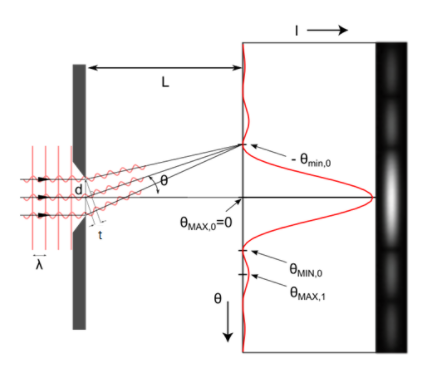
Answer
462.9k+ views
Hint: Diffraction is the property of the light where the light encroaches the regions are supposed to be dark. This is observed when the light is passed through a small aperture whose width is comparable to the wavelength of the light.
Formula Used:
$\theta=\dfrac{\lambda}{t}$
Complete step-by-step answer:
Single slit diffraction is observed when the light bends through the small aperture whose width is comparable to the wavelength of the light. This produces a diffraction pattern, with a central maxima and secondary minima. The difference between two consecutive secondary minima gives the secondary maxima.
Consider single silt with an aperture of width $d$ and placed at a distance $L$ from the screen. Let us assume that they are divided into $n$ smaller slits.

Then the width of $n$ small slits will be $t=\dfrac{d}{n}$
Then the angle of diffraction will be given as $sin\theta=\dfrac{n\lambda}{t}$
For small angles $sin\theta \approx tan\theta\approx \theta$
Then, we can say $\theta=\dfrac{n\lambda}{t}$
The position of central maxima $y=\dfrac{n\lambda L}{t}$
Central maxima is observed at $n=0$ with a width of $2\lambda Lt$ and angular with of $2\theta=2\lambda t$
For secondary destructive interference or for dark fringe $n=..-2,-1,1,2..$
Clearly, $n\neq 0$
Then clearly, the secondary minimum is a value close to zero but never zero.
Then the secondary minima can become zero, only if $t$ tends to be infinitely small.
Note: Students often confuse between diffraction and interference. Diffraction and interference occur simultaneously and hence it is hard to differentiate both by observing the pattern. However, Interference is a property where two coherent sources are used to produce two fringes of different intensity, whereas diffraction is observed when the secondary wavelets that originate from the same wave produce two fringes of different intensity.
Formula Used:
$\theta=\dfrac{\lambda}{t}$
Complete step-by-step answer:
Single slit diffraction is observed when the light bends through the small aperture whose width is comparable to the wavelength of the light. This produces a diffraction pattern, with a central maxima and secondary minima. The difference between two consecutive secondary minima gives the secondary maxima.
Consider single silt with an aperture of width $d$ and placed at a distance $L$ from the screen. Let us assume that they are divided into $n$ smaller slits.

Then the width of $n$ small slits will be $t=\dfrac{d}{n}$
Then the angle of diffraction will be given as $sin\theta=\dfrac{n\lambda}{t}$
For small angles $sin\theta \approx tan\theta\approx \theta$
Then, we can say $\theta=\dfrac{n\lambda}{t}$
The position of central maxima $y=\dfrac{n\lambda L}{t}$
Central maxima is observed at $n=0$ with a width of $2\lambda Lt$ and angular with of $2\theta=2\lambda t$
For secondary destructive interference or for dark fringe $n=..-2,-1,1,2..$
Clearly, $n\neq 0$
Then clearly, the secondary minimum is a value close to zero but never zero.
Then the secondary minima can become zero, only if $t$ tends to be infinitely small.
Note: Students often confuse between diffraction and interference. Diffraction and interference occur simultaneously and hence it is hard to differentiate both by observing the pattern. However, Interference is a property where two coherent sources are used to produce two fringes of different intensity, whereas diffraction is observed when the secondary wavelets that originate from the same wave produce two fringes of different intensity.
Recently Updated Pages
The radius of curvature of a plane mirror is a positive class 10 physics CBSE

Choose the word which is closest to the opposite in class 10 english CBSE

Select the antonym for the following word from the class 10 english CBSE

Select the synonym for the given word Transparency class 10 english CBSE

Select the given word which means the opposite of the class 10 english CBSE

The purest form of carbon is a Graphite b Diamond c class 10 chemistry CBSE

Trending doubts
How do you graph the function fx 4x class 9 maths CBSE

Which are the Top 10 Largest Countries of the World?

Fill the blanks with the suitable prepositions 1 The class 9 english CBSE

What is the meaning of sol in chemistry class 11 chemistry CBSE

The Equation xxx + 2 is Satisfied when x is Equal to Class 10 Maths

The capital of British India was transferred from Calcutta class 10 social science CBSE

Why is there a time difference of about 5 hours between class 10 social science CBSE

Capital of the Cheras was A Madurai B Muziri C Uraiyur class 10 social science CBSE

What organs are located on the left side of your body class 11 biology CBSE




